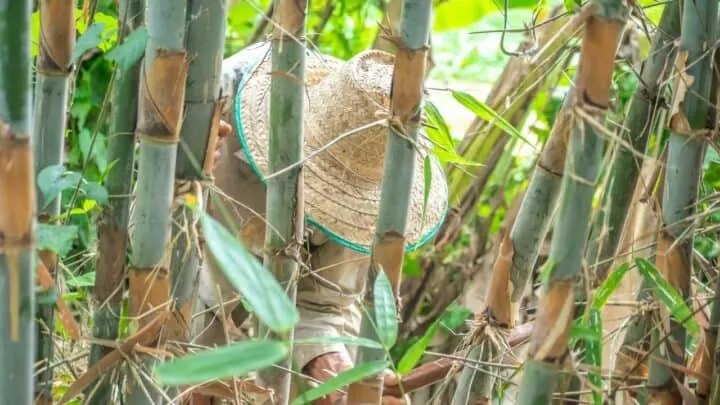Bamboo is a type of ornamental plant that you care for like you would your lawn. Regular pruning and trimming are essential for healthy and hardy bamboo so it doesn’t take over your yard and landscape.
There are nearly 1,000 different species of this decorative foliage, so make sure to prune routinely to encourage new growth and rejuvenation of leggy plants.
Thinking about bamboo in your landscape? Here is what you need to know!
Table of Contents
How to trim a bamboo plant?
There are basically four ways to trim your bamboo – for maintenance, thinning, legging-up, and topping. These methods are used to groom and restore your plant, as well as to ensure maximum exposure to the sun and optimal visual appeal of the plant. Plan to regularly prune your bamboo plant for best results.
Trimming a Bamboo Plant
The best time to trim and prune your bamboo depends on the type of bamboo planted. Generally, it makes the most sense to prune at the end of winter or the end of the spring season.
Consider the following four approaches to trimming your bamboo plant.
Maintenance
Maintenance trimming of bamboo begins with cutting away the dead bamboo culms, or stalks. Generally, these turn brown and dry when damaged and dead.
This helps restore and rejuvenate the plant so it can support new growth. Also, get rid of fallen stalks that may contribute to your bamboo being overcrowded.
Whenever you cut a stalk or culm, make sure to trim at the base of the trunk, near the ground, for best results later.
Thinning
Thinning your bamboo plants allows more airflow and sun exposure, which helps the plant grow. Plus, thinning out the stalks can make the plant more visually appealing in a landscape.
Only thin-out your bamboo plants when it is mature and well-established. Plan on thinning the plant once a year, either at the end of spring or winter seasons.
Cutting culms close to the ground helps you to avoid the eyesore of a brown stump in your landscape.
Legging Up
For aesthetic appeal that highlights the beauty of your bamboo, try legging-up, or limbing-up. This involves trimming the lower, leggy branches of the plant to expose the trunk and stem.
This gives the plant a more ornamental look and provides airflow for optimal growth.
Also, this method eliminates the scraggly, leggy branches that grow towards the bottom of a healthy bamboo plant, hence the name.
Topping
Topping a plant is a method commonly used in pruning taller plants or trees. This helps provide a sense of balance and evenness to the bamboo plant.
It also removes some of the weight from the top of your plant, which will make it seem taller and sturdier, too.
First, decide how tall you want your bamboo as well as choose how much you will remove when topping the plant. Inspect your bamboo from all angles and distances to make this determination.
Next, cut above the horizontal lines on the limbs, the nodes, and cut straight across.
Avoid trimming the excess foliage that may conceal the stems and stalks, as this can affect how lush your bamboo is.
Caring for Bamboo
Perhaps the most important element of caring for Bamboo plants is pruning and trimming, as some species can grow very tall.
If you ignore bamboo, it can become scraggly and leggy, less aesthetically pleasing than a maintained and trimmed plant.
Bamboo can grow fast and without regular maintenance, it may take over a landscape.
You can also install barriers of sorts to prevent your bamboo culms from leeching onto other areas of the property, or your neighbor’s!
The good news is that bamboo is hardy and resilient so do not be afraid to jump in and prune your plant!
Bamboo Cuttings
Before you discard the bamboo that you have pruned, consider some useful ways to re-purpose the clippings. These bamboo cuttings make excellent stakes for other greenery in your garden or landscape.
Some clever gardeners also use these for creating features like arbors or fencing for your green space.
Frequently Asked Questions about How to Trim a Bamboo Plant
How do you trim a bamboo plant?
Trim down your bamboo by cutting just above the nodes on the main trunk, using sharp shears or a saw. Make sure to cut straight across the stem, rather than at an angle.
What is the best soil for bamboo?
Bamboo does best when grown in loam. Strive for bamboo’s ideal pH level of six.
What tools are needed to trim bamboo?
The size of your bamboo culms dictates the best tools for trimming the plant. For smaller bamboo, use sharp, clean pruners. For larger plants, try a small saw.
Does bamboo thrive in winter conditions?
If your bamboo is hardy and healthy, it should survive cold weather and winter fine. If you live in a colder climate, choose bamboo species that are tolerant of cooler weather.
Does bamboo like the sun?
If you want the most growth for your bamboo, provide plenty of sun. While bamboo will thrive in shade, it will grow much more slowly. Check out the specific grow instructions for the distinct type of bamboo that you have as their needs vary.
Conclusion
Use these tips to trim your bamboo plant and keep it looking aesthetically pleasing.
Whether you are pruning for maintenance, to thin out the plants, ‘legging-up’, or topping, take care of your bamboo with regular trimming, much like you would your lawn or grass.

Daniel has been a plant enthusiast for over 20 years. He owns hundreds of houseplants and prepares for the chili growing seasons yearly with great anticipation. His favorite plants are plant species in the Araceae family, such as Monstera, Philodendron, and Anthurium. He also loves gardening and is growing hot peppers, tomatoes, and many more vegetables.


